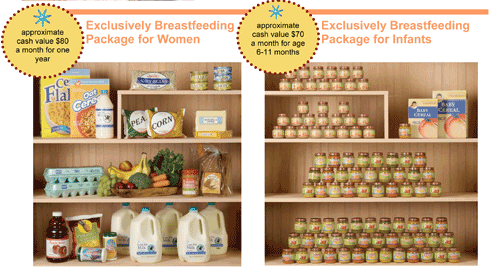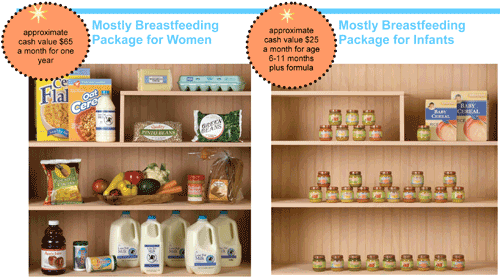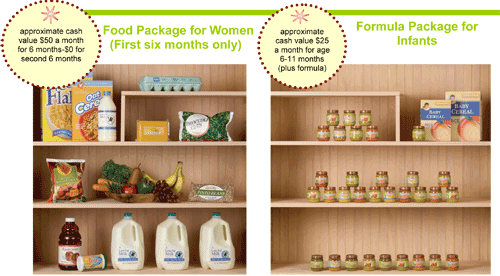DHHS → MECDC → Disease Prevention → WIC → Applicants → Breastfeeding
Breastfeeding - For Families
Maine WIC is committed to promoting breastfeeding, protecting a woman's right to breastfeed her child, and ensuring the availability of quality health care for breastfeeding mothers. We collaborate with and support health care professionals and community groups working to increase breastfeeding rates in Maine.
Many women have questions about breastfeeding. Each time you visit WIC, you have the chance to get answers to your questions.
At WIC, you can:
- Talk about your thoughts and concerns and learn about the benefits of breastfeeding.
- Get ideas for talking to family and others about how important it is to breastfeed.
- Learn about breast pumps, where to get one if you need one, and with ideas on how to continue breastfeeding when you return to work or school.
- Learn where to get additional breastfeeding help if you need it.
For more information on a number of areas involving breastfeeding, click on any of the buttons below:
Benefits of Breastfeeding
 Breast milk is the best food for a baby. It is always changing to meet a baby's needs. Breast milk contains just the right amount
of fatty acids, lactose, water and amino acids (protein) for a baby's digestion, brain development and growth.
Breast milk is the best food for a baby. It is always changing to meet a baby's needs. Breast milk contains just the right amount
of fatty acids, lactose, water and amino acids (protein) for a baby's digestion, brain development and growth.
Colostrum, the early milk produced by a breastfeeding mother, is rich in nutrients and antibodies. It is the perfect starter food for a baby.
There are many benefits to breastfeeding. Some are more beneficial to the mother while others are more important to the baby.
- Breastfeeding requires no special preparation.
- Breast milk is fresh, clean and at the right temperature.
- Breast milk is nutritionally superior to any alternative.
- Breast milk is the least allergic of any food for a baby.
- Breast milk has many special substances that protect against infection.
- Breastfed babies have fewer illnesses and stomach upsets.
- Breastfed babies are less likely to be overfed.
- Breastfeeding causes the mother's uterus to contract. This helps her body return to its pre-pregnancy shape.
- Breastfeeding promotes good jaw and tooth development.
- Breast milk is easy to digest and is gentle on the baby's stomach.
- Breastfeeding may help protect the mother against breast and ovarian cancer.
- Breastfeeding generally costs less than commercial formulas. Since there are usually no containers to wash, heat, or dispose of with breast milk, breastfeeding may have a positive environmental impact.
- Breastfeeding promotes a close mother-baby bond.
- Breastfeeding may help a mother return to her pre-pregnancy weight sooner.
WIC Benefits for Breastfeeding Moms
Next to giving birth, breastfeeding is one of the most important jobs a mother's body can do! Fully breastfeeding mothers and babies receive the largest quantity and variety of food benefits in the WIC program.



Fully breastfeeding mothers receive more milk, juice, cheese, and eggs compared to non-breastfeeding mother. Fully breastfeeding women also receive canned fish
Fully breastfed babies receive twice as much infant fruits and vegetables as babies who are receiving formula. Fully breastfed babies also receive jarred infant meats.
Breast Pump Program
To help mothers provide the best possible food – their own breastmilk – to their baby, the Maine CDC WIC Nutrition Program offers two different types of breast pumps.
Electric breast pumps may be loaned to WIC moms who are not providing formula to their babies and would like to pump milk for when they are separated from their baby. WIC participants who are loaned an electric pump also receive a milk-collection kit that is theirs to keep.
Manual breast pumps can be given to WIC moms for any reason.
Breast pumps are offered to participants based on need and availability. Call your local WIC clinic to see whether one is available for you.
Storing Breast Milk
Safely prepare and store breast milk. Use clean containers. Breast milk can be stored in glass or hard BPA-free plastic bottles with tight fitting lids and milk storage bags, which are sterile and made for freezing human milk. Do not use disposable bottle liners to store breast milk.
After pumping:
It is best to refrigerate or chill milk right after it is expressed. Label the date on the storage container and always use the oldest dated milk first.
Stored breast milk tends to separate in its container into two parts, what looks like cream rising to the top and then lighter colored milk. Human milk can look clear, bluish, yellowish, or brownish. Gently swirl the container to mix the cream back into the rest of the milk. Shaking the milk is not recommended as it can cause a breakdown of some of the milk's valuable components.
When freezing milk:
Wait to tighten bottle caps or lids until the milk is completely frozen. Try to leave an inch or so from the milk to the top of the container because it will expand when freezing.
Freeze the milk in small amounts, such as 2 to 4 ounce servings, to reduce waste if the baby does not finish all of it.
Thawing and warming up milk:
Breast milk does not necessarily need to be warmed. Some moms prefer to take the chill off and serve at room temperature. Some moms serve it cold.
If you want to warm the milk, never put a bottle or bag of breast milk in the microwave. Microwaving creates hot spots that could burn your baby and damage the components of the milk.
Hold the bottle or frozen bag of milk under cool and then warm water for a few minutes until it thaws, then warm to a comfortable temperature. You also can allow frozen milk to thaw to room temperature on a counter or other clean surface.
Or, heat a pan of water on the stove, remove from the heat and place the container into the warm water.
Swirl the milk and test the temperature by dropping some on your wrist. It should be comfortably warm.
Cool fresh milk in the refrigerator before adding it to milk that has been frozen.
Guide to Storing Fresh Breast Milk
for use with healthy full term infants
| Place | Temperature | How Long | Things to Know |
| Countertop, table | Room temp (up to 77 degrees F) Colostrum can be stored at room temp for up to 12 hours. |
6-8 hours | Containers should be covered and kept as cool as possible; covering the container with a cool towel may keep milk cooler. |
| Insulated cooler bag | 5-39 degrees F | 24 hours | Keep ice packs in contact with milk containers at all times; limit opening cooler bag. |
| Refrigerator | 39 degrees F | 5-8 days | Store milk in the back of the main body of the refrigerator. |
| Freezer compartment of a refrigerator | 5 degrees F | 2 weeks | Store milk toward the back of the freezer where temperature is most constant. Milk stored for longer durations in these ranges is safe, but the quality of the milk might not be as high. |
| Freezer compartment of refrigerator with separate doors | 0 degrees F | 3-6 months | Same as above |
| Chest or upright deep freezer | -4 degrees F | 6-12 months | Same as above |
| Thawed, Room Temp | (66 degrees F to 72 degrees F) | 1 hour | Do not refreeze. |
| Thawed, refrigerator | (32 to 39 degrees F) | 24 hours | Do not refreeze. |
Source: LaLeche League International and Academy of Breastfeeding Medicine
Breastfeeding Peer Counselor Program

As a new mother, you may have heard many things about how to feed your baby. You may know breastfeeding is the best way to give your baby a healthy start in life. You may wonder how breastfeeding can fit into your life and schedule. A WIC breastfeeding peer counselor can help.
Breastfeeding peer counselors are:
- Moms just like you who have breastfeeding their own baby
- Available day and night
- Trained to address your breastfeeding concerns
She supports breastfeeding mothers, and answers questions expectant, new or experienced moms have about nursing and pumping. Most of all, she supports your breastfeeding goals.
Talk to your WIC counselor about whether their office has a breastfeeding peer counselor.
Commonly Asked Questions
The First Month PDF
When should I breastfeed?
Watch your baby for signs of hunger and allow your baby to breastfeed as often as desired. Every baby is different, but most will nurse at least every 2 to 3 hours.
My baby is really sleepy during the day. Should I be waking my baby to eat?
Wake a sleeping baby if it has been longer than 3 hours during the day and 4 hours at night since the last nursing. It may take about five minutes to wake your baby. Rubbing baby's back, talking close to the baby's face or changing the diaper are all ways to help wake a sleepy baby.
I know that breastfeeding is best for my baby but it feels really strange to me. Is this normal to feel this way?
Some new moms feel breastfeeding is awkward and uncomfortable at first. With a little bit of practice, you will begin to feel more comfortable with and enjoy breastfeeding.
How long should a feeding last?
Feedings will usually last between 15-45 minutes. Allow your baby to stay on the breast as long as there is continued sucking and swallowing. You will know that your baby is finished when sucking stops and baby lets go of the breast.
| Day | Feedings | Wet Diapers | Dirty Diapers |
| 1 | 6-8 | 1 or more | 1 or more |
| 2 | 6-8 | 2 or more | 2 or more |
| 3 | 8-12 | 3 or more | 3 or more |
| 4 | 8-12 | 4 or more | 4 or more |
It seems like my baby wants to breastfeed all the time. How can I tell if my baby is getting enough milk?
The number of wet and dirty diapers is the best way to tell if your baby is getting enough milk. The number of nursings and the number of wet and dirty diapers will increase each day for the first four days of life. However, after baby is four weeks old, it is normal to notice the number of dirty diapers decrease.
When should I seek help with breastfeeding?
While many mothers and babies adjust easily to breastfeeding, others sometimes have trouble getting started. Ask for help if:
- Baby is unable to hold a proper latch
- No sign baby is getting milk
- Severe breast pain while nursing
- Less than 3 dirty diapers on day 3
- Baby continues to lose weight on day 5
- Below birth weight at 2 weeks
- Baby seems weak, tired and not interested in feeding
Where can I go for help with breastfeeding?
There are many resources available to help you and your baby get off to a good start.
- Birthing unit at hospital where you delivered
- Local WIC office
- Lactation consultant
- Baby's health care provider
- La Leche League Helpline 1-877-452-5324
- Maine La Leche League listings
 of local groups and volunteers
of local groups and volunteers
Breastfeeding and Your Workplace
Breastfeeding Protection in Maine: The Nursing in Public Law
Maine Workplaces Support Nursing Moms poster (PDF)
Maine law (5MRSA §4634) provides protection for women who nurse in public. A mother may breastfeed her baby in any location, public or private, where the mother is otherwise authorized to be.
Medical experts recommend breastfeeding your baby until his/her first birthday. Yet many mothers want or need to return to work far sooner than that.
Feeding your baby while you're at work requires a little bit of preparation, but is still healthier and less costly than switching to formula. Talk to your local WIC office about obtaining a breast pump to use to express milk while at work to be given to your baby later.
Before the baby is born
During your pregnancy, talk with your employer about your plans to return to work, and ask about arrangements for breastfeeding mothers. According to Maine law, employers must provide a clean and private place (not a bathroom) for breastfeeding women to express breast milk on scheduled breaks for up to three years after childbirth.
By supporting breastfeeding, your employer actually supports your work! Breastfeeding helps build your baby's immune system, meaning you will miss less work due to your child's illnesses.
Before you go back to work
Practice expressing milk by hand or using a pump. Freeze 2 to 3 ounces at a time to save for when you go back to work. Ideally, try to pump or nurse at about the same times that you will be taking your breaks at work. This will also give you time to get used to using and cleaning the pump and work out any issues (make sure you have the right size flanges for your breasts, for example).
Help your baby get used to taking breastmilk from a bottle (or, if she is old enough, a cup).
When you go back to work
If you can, arrange to return gradually, so that you and your baby have a chance to settle into the new routine.
Set up a household routine for your return to work. Plan who will do laundry, cooking, shopping, errands and housecleaning. Be sure to allow time to clean and sterilize your pump.
Prepare your baby's diaper bag the night before so that you just need to add the milk before you leave.
If you are picking your baby up from day care, see if you can sit for a few minutes together and breastfeed before going home. This will give you both a chance to relax and reconnect, and will make the ride home less stressful.
Pumping at work
Take a few moments to relax from the stress of the workday. Stimulate your milk flow by breathing deeply and thinking about your baby. Bring a photo or other item that reminds you of your baby. Visualize milk flowing down and nourishing your child. You may need to massage your breasts or gently rub your nipples. If your pump is adjustable, set the suction to feel as much like your baby as possible.
Take the same number of breaks to pump that you would need to take to feed your baby if you were not at work. Usually, this works out to two or three 15-minute breaks in an eight-hour shift. Be sure you and your supervisor have a clear understanding about when you are allowed to take your breaks. If time is an issue, consider using an electric pump that will allow you to express milk from both breasts at once, thus allowing you to take shorter breaks.
Store your milk in a refrigerator (clearly labeled with your name and the date you expressed it) or in a cooler with ice packs until you can bring it home.
Consider keeping an extra top or outfit at work in case of a spill.
Baby-Friendly Hospitals
The Baby-Friendly Hospital Initiative is a global program sponsored by the World Health Organization and the United Nations Children's Fund to encourage and recognize hospitals and birthing centers that offer an optimal level of care for breastfeeding.
Maine hospitals that have become designated 'Baby Friendly' hospitals include:
- Bridgton Hospital,
 Bridgeton, ME
Bridgeton, ME - Central Maine Medical Center,
 Lewiston, ME
Lewiston, ME - LincolnHealth,
 Damariscotta, ME
Damariscotta, ME - Maine General Medical Center,
 Waterville, ME
Waterville, ME - Stephens Memorial Hospital,
 Norway, ME
Norway, ME - York Hospital,
 York, ME
York, ME
Breastfeeding and Dad
What's Dad Got to Do With It?
A mom who has the support of her baby's father is more likely to stick with breastfeeding and that means a stronger, healthier baby.
The number one reason to support breastfeeding is that it gives your baby a great source of nutrition. But dads who've been there say they also like the low cost and the convenience a baby who gets hungry in the middle of the night has an instant source of satisfaction instead of fussing and crying while formula is prepared and heated.
From the very beginning, you can do things with your baby to form a bond between you two carrying him, holding him, showing him the world. Babies love skin-to-skin contact, and you may enjoy just talking and smiling with your baby on your bare chest, snuggled under a blanket.
Other ways dad can help:
- In the first days of your baby's life, encourage frequent feeding this will help ensure a good supply of milk for your baby.
- Bring the baby to your partner when it's time to nurse.
- Use pillows to support your partner and the baby in a comfortable feeding position.
- Bring a warm towel to help wipe up spills and soothe mom's breasts.
- After a feeding, burp the baby and change his diaper while mom has a hot shower.
- If there are problems with breastfeeding, seek help and information to solve them.
- Let your baby's mom know that she's a good mother and that you love that she's giving your baby the best food.
- Make sure mom eats properly even when the baby is taking up most of her energy.
- Encourage your partner to take breaks and spend time out of the house.
- Touch, hold and rock your baby.
- Talk to your baby in calm, gentle tones. Many babies find it easier to go to sleep with a male voice talking to them.
- Once the baby is a few weeks old, take your turn feeding a bottle of expressed breast milk.
- Act as a "human shield" to preserve mom's privacy when nursing in public.
- Learn about breastfeeding and child development, so that you understand the benefits of breastfeeding.
- Resist the temptation to calm your baby with breast milk substitutes (pacifiers, formula).
- Encourage your partner to stick with breastfeeding even if it doesn't come easily.
- Head off critical comments from extended family and affirm your shared decision to breastfeed.
Remember that you two are a team, and your baby needs both of you!
More Web Resources
Questions? Want to sign up? Contact your local WIC clinic.
York County Community Action Corp – York County
- Sanford: 207-459-2942
- Biddeford: 207-283-2402
The Opportunity Alliance – Cumberland County
- Portland: 207-553-5800
Western Maine Community Action – Androscoggin, Franklin, and Oxford Counties
- Auburn: 207-795-4016
- Wilton: 207-645-3764
Midcoast Maine Community Action – Lincoln, Knox, Waldo, and Sagadahoc Counties
- Bath: 207-442-7963
- Belfast: 207-338-1267
- Rockland: 207-594-4329
Maine General – Kennebec and Somerset Counties
- Augusta: 207-626-6350
- Waterville: 207-861-3580
- Skowhegan: 207-861-3593
Bangor Public Health & Community Services – Penobscot and Piscataquis Counties
- Bangor: 207-992-4570
Maine Family Planning – Washington and Hancock Counties
- Ellsworth: 207-667-5304
- Machias: 207-255-8280
- Calais: 207-454-3634
Aroostook County Action Program – Aroostook County
- Presque Isle: 207-768-3026
State Contacts for VOC Requests
State Agency Contact Information
- Monday - Friday 8am-5pm
- Phone: (207) 287-3991
In-state Toll Free:
1-800-437-9300
TTY: Maine relay 711
- Email:
Main: WIC.Maine@maine.gov
Vendor: WICVendor@maine.gov - Mailing address:
11 State House Station
Augusta, ME 04333

